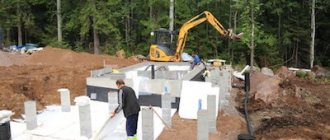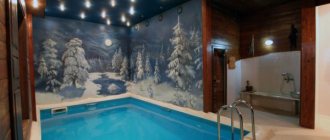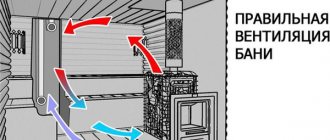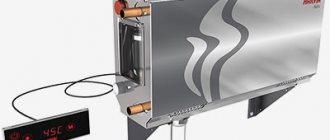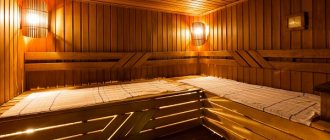Air saturated with oxygen is vital for people. Especially if the person is in a closed space. Therefore, ventilation in a sauna, bathhouse, bathroom and other rooms with high temperatures and humidity levels must be arranged correctly.
Otherwise, you may encounter a lot of unpleasant surprises and their negative consequences. The consequences include not only harm to health, but also damage to building structures, the development of fungus, and the gradual destruction of the building.
You will learn everything about the methods and features of organizing ventilation for Finnish and Russian steam rooms equipped with electric and wood stoves on our website. We will talk about the specifics of the design of air supply and exhaust systems. Let's list the typical mistakes that occur when the construction is not done correctly.
Specifics of the ventilation device in the sauna
In a sauna, a high level of temperature and humidity usually prevails; without adequate air exchange, fungus and mold quickly grow here, since wood is the main building material. In the absence of a well-thought-out inflow-outflow system, the service life of the room and the stove installed in it is reduced several times.
With insufficient air exchange, irritating odors accumulate, the sources of which are mold processes, wood destroyed as a result of rotting, and sweat released by steam room users. Over time, these aromas are literally absorbed into all surfaces, becoming stronger as the air temperature rises, which negatively affects the comfort of relaxation in the sauna.
An improperly designed ventilation system can lead to the proliferation of pathogens indoors. Instead of the positive effect of staying in a steam room, users may get sick.
To determine insufficient air exchange, you should pay attention to several points:
- the walls and ceiling are covered abundantly with condensation;
- a burning match, located as an indicator at the exhaust hole, produces a strictly vertical flame that practically does not fluctuate;
- When entering the sauna, a musty smell is strongly felt.
You can determine the lack of ventilation by holding a burning match to the exhaust hole
. If there are no obvious greasy marks on the exhaust grille, it means that the system is ineffective - during vaping this metabolic product is always released, and it should preferentially settle where the air flows go.
Sanitary standards
It is calculated that at rest a person needs from 20 to 25 liters of air per hour. In a sauna, a person not only relaxes, but also steams and washes, so consumption increases. But without ventilation, clean air is replaced by carbon dioxide, which is called the “invisible danger.”
The result of a long stay in such a “gassed” room is a loss of strength, a headache, so instead of being cheerful, people who are in a sauna without ventilation “on the way out” experience a deterioration in well-being, therefore the effect of the procedures is minimal.
If we add the smell of sweat, which “leaks out” in the steam room at a rate of a liter per hour, then the situation looks completely bleak. Its fumes add an unpleasant odor to an already stuffy, unventilated room.
Air exchange
The minimum air change rate is 20 m3/h. If there are three people in a regular steam room with a volume of 10 m3, then the air should be renewed 5-6 times per hour. For dry saunas the requirements are stricter - at least 10 times. And this condition cannot be met without high-quality ventilation.
Even a very wide gap between the floor and the steam room door cannot save the situation. It is better if the influx is carried out directly from the street, and not from internal, adjacent rooms, since the incoming air must have the maximum amount of oxygen.
Pipe characteristics
To create a high-quality ventilation system, it is necessary to guarantee proper air exchange, so future sauna owners need to adhere to several recommendations.
- The diameter of the exhaust duct must be no less than the diameter of the supply pipe.
- The cross-section of the air ducts is chosen in proportion to the volume: 24 cm2 is required per 1 m3 of room. A low draft force will make the system ineffective; a powerful draft, on the contrary, will not allow creating an optimal temperature regime in the sauna.
The diameter of the pipes in the designs of different countries differs. As an example, we can cite 3 saunas with accepted inlet and outlet diameters. These are Russia - 100 and 100 mm, Finland - 130 and 100 mm, Sweden - 100 and 80 mm, respectively.
Ventilation and sauna rooms
A separate bathhouse building requires a layout that takes into account all the rooms in it. Usually the steam room is equipped with natural ventilation. The washing room is often equipped with a mechanical version. For a rest room, a simple system without additional equipment is suitable. If there is a utility room where all the necessary accessories are stored, then you can install a forced hood in it, which will be started by a light switch.
Proper sauna ventilation: technical requirements
Supply and exhaust ducts in the steam room should be designed in such a way as to create air balance. The masses should not stagnate or be rapidly removed; the outflow and inflow should be regulated so that it is possible to predict the direction of the flows. The formation of drafts is unacceptable.
When deciding how to properly ensure air exchange in a sauna, you need to design it correctly at the initial stages: at least one wall of the steam room must border on the street - an exhaust hole will be made in it. Under the door leading directly to the heated area, it is necessary to provide a two-centimeter gap.
Every hour there should be at least 4 complete changes of air in the room, the flows should be directed from the recreation area to the utility areas and bathrooms. The system is designed so that the air passes from the steam room to the washing room with toilet, then to the vestibule and onto the street.
The outlet of the exhaust duct must be above roof level. The inflow, in turn, is installed at a level no higher than 50 cm from the floor in close proximity to the stove on the wall opposite the exhaust air duct. The introduction of forced air exchange is accompanied by the installation of a ventilation grille; it is located 2 meters above ground level.
If a gas water heater is used in conjunction with a steam room, a separate exhaust duct is installed for it. It is advisable, if possible, to reuse the hot air generated in the steam room: for example, it can be directed to heat the rooms adjacent to the sauna.
Standard diagrams of ventilation systems
Mechanical diagram
At the same time it is the most expensive, but also the most effective. The kit will require ventilation valves for the sauna, filters, diffusers, a device for neutralizing noise and other components.
Natural ventilation
This type of sauna and steam room ventilation is considered the easiest to organize with your own hands. But this can only be said about the process of its installation, because sufficient air exchange can be organized only after accurate calculations. In addition, such a system also has a number of negative aspects. For example, it depends on the wind speed and its direction.
Supply and exhaust ventilation system
Such a hood in a sauna can rightfully be considered the best engineering solution. It combines efficiency, low cost and is easy to do yourself.
It is advisable to install this type of ventilation in a steam room; in other rooms, such as a dressing room or a rest room, it is enough to organize a natural ventilation system (pro
How to make ventilation in a sauna: types and diagrams
The air exchange system can be natural, mechanical or combined. The last two types require the introduction of supply and ventilation equipment.
Natural ventilation
This scheme is based on the pressure difference between indoors and outdoors. Its main advantages are low cost and ease of operation, no need for expensive maintenance and the ability to install it yourself. Natural ventilation is based on the laws of wind pressure or aeration.
Natural ventilation of the sauna is carried out through vents in the lower segment of the steam room
As it moves upward, it displaces hot masses, thus directing them into the air duct. This solution is optimal for servicing very hot rooms in which steam is used abundantly - in such conditions there is intense air exchange.
Wind pressure is provided only in saunas made of logs. The necessary air pressure is created by strong gusts of wind, and a rarefied atmosphere appears on the leeward side. Streams through the cracks between the logs enter on one side and exit on the other.
The natural method does not involve regulating air exchange parameters. If there is a strong wind, a draft will occur and it will be difficult to maintain the required temperature.
Mechanical System Features
Forced schemes are used in cases where it is not possible to create a natural inflow and outflow. This requires expensive equipment - filters, coolers, fans, heaters.
Forced outflow is provided using exhaust fans. The equipment filters the air before it is released outside. Artificial evacuation of waste masses is most necessary in large saunas with washing rooms and in intensively used steam rooms. The system is useful for quickly getting rid of foreign odors and gases.
Mechanical ventilation in steam rooms made of wood involves the use of forced air flow from the street
Such a system has a complex configuration; it necessarily includes noise reduction devices, check valves, distribution grilles, a supply chamber and diffusers. Before serving in the sauna, the street masses are heated and filtered.
The simplest scheme of combined supply and exhaust ventilation is to create a supply opening 20 cm above the floor near the stove, and install an exhaust opening on the opposite wall. The street air, heated by the hot stove, gradually rises. This mass, as it cools, falls towards the exhaust duct. This solution helps maintain a high temperature in the sauna, while ensuring the supply of oxygen in the proper volume.
If only one wall of the steam room is in contact with the street, inflow and exhaust are installed on one wall - the first near the floor, the second near the ceiling along with a fan.
List of basic rules and recommendations
To begin with, the following conditions should be provided:
- organize a continuous flow of fresh air from outside;
- ensure a constant temperature in the rooms, especially in the steam room, as it should be very high there.
The ventilation systems of saunas and baths are quite similar, but there are also differences, since the latter differ in the way the air is heated - a dry microclimate is created for the sauna. In this regard, simply taking a ventilation scheme in a sauna and applying it to a bathhouse will be absolutely unacceptable.
Rules and regulations for arranging a ventilation system
Due to the fact that almost all rooms in the sauna have a minimum square footage, it is better to install such fans for the bathhouse and sauna so that fresh air flows at least every 15 minutes.
During the creation of the project and subsequent installation, it will be necessary to solve all problems with the possibility of drafts, as well as places with stagnant air.
Arrangement of ventilation in a sauna with an electric heater
Do-it-yourself installation begins with arranging a special channel in the sauna, which will provide a flow of fresh air to the heater; this air duct is located under the floor in close proximity to the heat source. The cross-section of the stroke should be a quarter smaller than the box for the hole. Oxygen will come from the street. The box is installed along the baseboard, it is protected from the inside by a grille, and a mesh is installed on the outside to prevent the penetration of insects.
An exhaust channel is made diagonally to the supply channel, which is responsible for the outflow of air. It should be placed at a height of 23-27 cm in relation to the floor. This outlet extends to the ceiling and from there goes out onto the street. To install a high-quality ventilation system, it is recommended to use plastic pipes.
Requirements for developing a ventilation circuit
In order to successfully complete the entire planned list of work, you need, at a minimum, to take a meaningful approach to the implementation of technological operations, study practical recommendations and photos of various options for exhaust systems.
The master must clearly see at each stage the result of his work, how much time it will take, how much money will need to be spent on arranging the ventilation system, and whether he can perform all the operations with his own hands.
Common mistakes
If you provide only one ventilation vent under the ceiling through which exhaust air will be discharged - even with a damper, it will quickly remove heated masses. This design flaw complicates the process of achieving the optimal temperature in the steam room and leads to a significant increase in fuel consumption.
If all functional openings - supply and exhaust - are located at the same height in relation to the floor, a draft will appear. There will be minimal air exchange, which is not effective enough to fully service the room.
Another common mistake is when the diameter of the supply duct is larger than the exhaust duct, in which case air exchange will also be difficult. To choose the optimal ratio of the air duct, you need to use the standard rule: for every cubic meter of steam room there are 24 square meters. cm sections.
Finnish bathhouse on the territory of communal living space: advantages and features of operation
The mini-sauna must have environmentally friendly materials
For a city dweller, placing a sauna in the bathroom will be a rational way out of the situation:
- The necessary utilities have already been installed: water supply, electricity, sewerage, air exchange.
- There is no need to lay a separate outlet for exhaust air, because it is removed through the bathroom duct.
- No redevelopment is required, which means no coordination of construction with permitting services.
Important! Current regulations prohibit building a sauna in cottages and residential premises of category l. Redevelopment of an apartment into a Finnish bathhouse is permitted only after agreement with the BTI.
In general, in different regions the requirements for coordinating a sauna plan (option for an apartment) are different. The list of organizations can be supplemented by the inspection for control of the housing stock, Rospotrebnadzor, Sanitary and Epidemiological Service, Rostechnadzor, etc.
All work on the placement, connection of the sauna and ventilation is carried out in accordance with SP 31-107-2004, which takes into account architectural and planning solutions for multi-apartment residential buildings, as well as SNiP 31-01-2003 relating to these structures.
Effective ventilation is necessary in all areas of the bathhouse
Proper ventilation for a bath should comply with the following principles:
- when designing a bathhouse, the optimal air exchange scheme is selected;
- arrangement of ventilation ducts, supply and outlet vents is carried out during construction;
- the area of the exhaust opening must necessarily exceed the area of the inlet opening, otherwise it will not be possible to achieve access to the required amount of fresh air;
- the calculation of the area of the ventilation hole is made from the dependence of 24 cm2 of the vent area per one cubic meter of room volume;
- It is forbidden to place the exhaust and supply openings on the same straight line to avoid disrupting the correct air circulation;
- Ventilation valves for the bathhouse must be installed at the inlet and outlet openings.
The presence of adjustment of the live cross-section of inflow and outlet allows you to:
- significantly speed up the achievement of the desired steam room temperature with closed ventilation;
- achieve comfortable conditions by regulating the intensity of air exchange;
- adapt to weather conditions.
Conclusion
Sometimes the design of a bathhouse, or rather the location of the premises in it, does not allow one to limit oneself to natural ventilation only, so it will not be possible to get rid of air ducts at all. As an alternative, we can offer you installation of them in the attic. But this requires special knowledge, otherwise there is a risk of making mistakes in the calculations.
CAREFULLY. Do not use plastic pipes for ventilation (especially in a steam room); under the influence of high temperatures they can become deformed and also release substances harmful to humans.
Thanks to our article, you have become acquainted with most of the most popular schemes for organizing ventilation in a bathhouse, with the help of which you can draw a conclusion: do the ventilation yourself or enter into a contract with a specialized organization).
See also the material about ventilation of the steam room in the section of the site on ventilation in the bathhouse.
Article in sections: Ventilation in the bathhouse
Why is ventilation needed at all?
- The first and most important task of this system is to ensure a comfortable stay for people in the bathhouse. After all, in the steam room the air should be not only hot, but also fresh. Otherwise, instead of the pleasure of visiting the bathhouse, you may get a real headache due to lack of oxygen.
- Do not forget that although the Finnish sauna is heated with dry steam, the humidity there is still quite high, and mold will sooner or later grow in any damp room.
- In addition, most modern saunas are equipped with electric heaters, and with high constant humidity, the likelihood of breakdown of electrical equipment increases significantly.
- It should also be mentioned that the interior decoration of the steam room is made of natural wood, and the wood should not be coated with any varnishes or impregnating solutions. Pure wood is very hygroscopic; it absorbs moisture and with it all odors. Hence, there is a high probability that after a short time there will be a persistent smell of sweat in the steam room.
- Therefore, to the question of whether ventilation is needed for a sauna, the answer is obvious. This system is not only necessary, but we can safely say that without it you will not get any pleasure from visiting the bathhouse at all.
Air distribution in the steam room.



